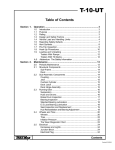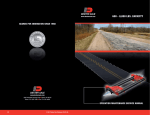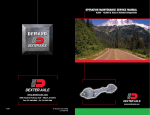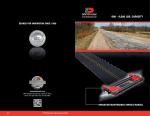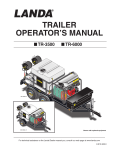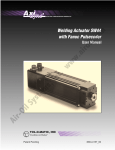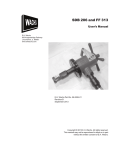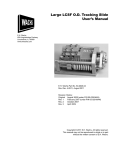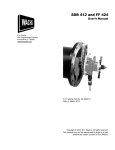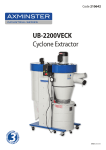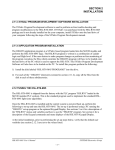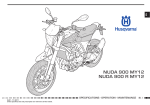Download Dexter Axle Hydraulic Brakes
Transcript
The hydraulic brakes on your trailer are much like those on your automobile or light truck. The hydraulic fluid from a master cylinder is used to actuate the wheel cylinder which, in turn, applies force against the brake shoes and drum. The main difference between automotive hydraulic brakes and hydraulic trailer brakes is the trailers' actuation system. These systems respond to the braking signal from the tow vehicle and supply the required brake fluid volume and pressure to the trailer brakes. CAUTION The operating pressure required for Dexter brakes: • 7" diameter brakes maximum operating pressure is 750 PSI • 10" diameter and larger maximum operating pressure is 1,000 PSI -23- Braking Systems - Hydraulic Hydraulic Drum Brakes Hydraulic Brake Operation Duo-Servo The duo-servo brake uses a dual piston wheel cylinder to apply the brakes. This type of brake is typically used in a vacuum/ hydraulic, electric/hydraulic or air/hydraulic system. A description of operation of this brake is as follows: Braking Systems - Hydraulic When the brakes are applied, the double-acting wheel cylinder moves the primary and secondary shoes towards the drum. The frictional force between Anchor Post the brake drum and lining Hydraulic Wheel Retractor attempts to turn the Cylinder Springs primary shoe into the secondary shoe. The Backing Actuating Pin secondary shoe is forced Plate onto the anchor pin and Hold Down from this point, the Spring Secondary secondary and primary Shoe shoes attempt to "wrap Primary Shoe Adjuster Spring around". In essence, the Adjuster Assembly brake has utilized frictional force to help the applying force on both shoes. If the brakes are applied while the vehicle is backing, the shoes rotate in the direction of the drum rotation. This causes the secondary shoe to leave the anchor and causes the primary shoe to move against the anchor. Action of the brake is the same in reverse as forward. Uni-Servo This type of hydraulic brake utilizes a single acting cylinder. Upon actuation, the primary shoe is pressed against the brake drum, which causes the shoe to move in the direction of rotation. This movement in turn actuates the secondary shoe through the adjuster link assembly. Braking in reverse is significantly less effective than in the forward direction. -24- Self Adjusting Mechanism for 121/4" Hydraulic Brakes Forward self-adjust hydraulic brakes were introduced in March, 1997. This feature adjusts the brakes on both forward and reverse stops. Brake adjustment occurs only when lining wear results in enough gap between the shoes and the drum surface. This added clearance will allow the adjuster mechanism to rotate the screw assembly at the bottom of the brake. That action expands the distance between the shoes and thus closes the gap to the drum surface. Hydraulic Parking Brake Option The parking feature on Dexter hydraulic brakes is cable operated. On the 10" and 12" brakes, the parking cable body is mounted to the brake backing plate. The cable end is attached to the internal parking brake lever to actuate the brake. On Dexter 121/4" brakes manufactured before February 2002, the parking cable body mounts to a support plate which is attached to the brake mounting flange. The cable end is routed through the dust shield and the brake spider to attach to the internal parking brake lever. -25- Braking Systems - Hydraulic Another variation is called a “free backing” brake which is commonly used on trailers with a surge hitch system. When backing with a surge brake hitch, normal brakes Anchor Post are applied through the Hydraulic Wheel Retractor Cylinder surge mechanism and if Springs there is more brake force Backing on the trailer than the tow Actuating Pin Plate vehicle can override, no Hold Down backing is possible. The Spring Secondary free backing brake was Shoe developed to allow Primary Shoe Adjuster Spring backing in this application. Adjuster Assembly This brake has a primary shoe on a pivot which allows normal application in the forward direction, but allows the primary shoe to rotate away from the drum surface when backing. For 121/4" brakes produced after February 2002, a short cable is installed directly into the backing plate to provide a convenient means for the trailer manufacturer to attach an appropriate operating system. The internal parking brake lever of 10" and 12" Dexter brakes, which is mounted to the secondary shoe, transfers applied cable force through a parking strut which is attached to the primary shoe. This transferred load generates a spreading force between the primary and secondary shoes. The shoes move toward the drum until contact is made. Friction generated between the drum and lining contact surface results in parking brake capability. The internal parking brake lever of Dexter 121/4" brakes transfers the applied cable force through a cam mechanism. The cam mechanism generates a spreading force between the primary and secondary shoes. The shoes move toward the drum until contact is made. Friction generated between the drum and lining contact surface results in parking brake capability. Braking Systems - Hydraulic Park Lever Park Cable -26- Dexter Axle manufactures two types of disc brakes, the floating caliper and the fixed caliper brake. With both styles, the disc brake uses friction pads astride a ventilated rotor which is attached to the wheel hub. When the brake is actuated, the pads are pressed against the sides of the rotor causing drag to slow the rotating disc. This action converts the kinetic energy (motion) into heat. The heat is dissipated rapidly by the ventilated disc. The floating caliper brake uses piston(s) situated on one side of the brake rotor. Hydraulic fluid pressure pushes against the piston(s) to apply the inboard brake pad. As the inboard pad exerts force against the rotating rotor surface, the caliper moves laterally towards the trailer frame and in turn applies an equivalent force to the outboard brake pad against the rotor surface. As the lining material wears, the caliper will automatically maintain the proper lining to rotor clearance. The floating caliper design is used on Dexter 3,500, 10,000, and 12,000 lb. axle models. The fixed caliper method uses pistons situated on both sides of the rotor. During actuation, hydraulic pressure pushes against the pistons to apply the inboard and outboard brake pads equally to decelerate the rotating rotor. The caliper is fixed and stays stationary during brake actuation and brake adjustment. Brake pad to rotor clearance is maintained as lining wear occurs via the brake piston and internal caliper seal. The fixed caliper design is used on the Dexter 6,000 lb. and 8,000 lb. axle models. Disc brake effectiveness is the same going either in a forward or reverse direction. All Dexter disc brakes should be actuated with a braking system that is capable of providing a maximum hydraulic pressure of 1,600 psi. -27- Braking Systems - Hydraulic Disc Brakes Actuation Systems To effectively operate your hydraulic trailer brakes, Dexter recommends the Predator E/H™ electrohydraulic actuator, powered by the Predator series DX2™ electronic brake controller. These high performance hydraulic power modules will supply pressurized brake fluid to your trailer brakes in proportion to the amount of braking effort called for by the towing vehicles' deceleration rate. Braking Systems - Hydraulic The Predator E/H 1000™ will supply 1000 psi for your drum brakes and the E/H 1600™ will generate 1600 psi for maximum output from your Dexter disc brakes. The sealed, watertight housing contains the electronics necessary to control the high pressure piston pump and proportioning valve for smooth, efficient braking. Troubleshooting Guide Brakes are slow to respond 1. Re-bleed the trailer brakes and actuator. 2. If the trailer is equipped with drum brakes, readjust the drum brakes to the trailer manufacture's recommended running clearance. -28- Unit will not run when the ignition is on and the brake pedal is depressed 1. Verify that the trailer and tow vehicle are wired as detailed on the electrical schematic. 2. With the ignition switch on and the brakes not applied, you should have 12-13 volts between the black and white wires on the Predator E/H™ unit. 3. Clean and replace the ground between the trailer and the Predator E/H™ actuator. 4. Test operation of the unit using the breakaway test procedure. Breakaway test procedure - do not leave the breakaway switch pulled for more than two minutes during any of the steps outlined below 1. Pull the breakaway switch on the trailer. 2. If the unit runs and builds pressure, that indicates the actuator is functioning properly. The problem most likely is a defective electronic brake controller in the tow vehicle or defective wiring between the tow vehicle and the Predator E/H™ unit. 3. If the unit runs but will not build pressure, the problem most likely is a defective solenoid valve in the Predator E/H™ unit and the actuator should be returned for repair. -29- Braking Systems - Hydraulic 3. Slow response can be caused by trailer wiring that is too small. 4. For trailers where the Predator E/H™ is located less than 10 feet from the tow vehicle, 12 gage wire is recommended for the black and white wires between the tow vehicle and the Predator E/H™ unit. All other wires should be a minimum of 16 gauge. 5. For trailers where the Predator E/H™ is located more than 10 feet from the tow vehicle, 10 gage wire is recommended for the black and white wires between the tow vehicle and the Predator E/H™ unit. All other wires should be a minimum of 16 gauge. 6. Slow response can be caused by improper adjustment of the brake controller. On inertia-based electronic brake controls, adjust the pendulum (inertia sensor) to a more aggressive setting and/or increase the gain setting. 4. If the unit still does not run after the breakaway battery is fully charged, verify that the voltage between the white wire and blue with white stripe wire (or yellow wire) is at least 12 volts. 5. If the voltage is less than 12 volts, either the breakaway switch or the breakaway wiring is defective. 6. If the voltage is greater than 12 volts, the Predator E/H™ actuator should be returned for repair. Braking Systems - Hydraulic Trailer brakes too aggressive 1. Reduce the gain setting on the in-cab electronic brake controller. -30- Drum Brake Adjustment - Manual Brakes should be adjusted (1) after the first 200 miles of operation when the brake shoes and drums have “seated,” (2) at 3,000 mile intervals, (3) or as use and performance requires. The brakes should be adjusted in the following manner: 1. Jack up trailer and secure on adequate capacity jack stands. Follow trailer manufacturer's recommendations for lifting and supporting the unit. Make sure the wheel and drum rotates freely. ! CAUTION Do not lift or support the trailer on any part of the axle or suspension system. Never go under any trailer unless it is properly supported on jack stands which have been rated for the load. Improperly supported vehicles can fall unexpectedly and cause serious injury or death. 2. Remove the adjusting hole cover from the adjusting slot on the bottom of the brake backing plate. 3. With a screwdriver or standard adjusting tool, rotate the starwheel of the adjuster assembly to expand the brake shoes. Adjust the brake shoes out until the pressure of the linings against the drum makes the wheel very difficult to turn. Note: For drop spindle axles, a modified adjusting tool may be necessary. 4. Then rotate the starwheel in the opposite direction until the wheel turns freely with a slight lining drag. 5. Replace the adjusting hole cover and lower the wheel to the ground. 6. Repeat the above procedure on all brakes. For best results, the brakes should all be set at the same clearance. -31- Braking Systems - Hydraulic General Maintenance - Hydraulic Brakes Most of the brake components are very similar to those used in electric brakes, and maintenance is comparable for the hub and drum, shoes and linings, and bearings. Specific maintenance activities are as follows: Wheel Cylinders Inspect for leaks and smooth operation. Clean with brake cleaner and flush with fresh brake fluid. Hone or replace as necessary. Brake Lines Check for cracks, kinks, or blockage. Flush with fresh brake fluid. Bleed system to remove all air. Replace as necessary. Braking Systems - Hydraulic Shoes and Linings A simple visual inspection of your brake linings will tell if they are usable. Replacement is necessary if the lining is worn (to within 1 /16" or less), contaminated with grease or oil, or abnormally scored or gouged. Hairline heat cracks are normal in bonded linings and should not be cause for concern. When replacement is necessary, it is important to replace both shoes on each brake and both brakes of the same axle. This will help retain the “balance” of your brakes. ! CAUTION POTENTIAL ASBESTOS DUST HAZARD! Some older brake linings may contain asbestos dust, which has been linked to serious or fatal illnesses. Certain precautions need to be taken when servicing brakes: 1. Avoid creating or breathing dust. 2. Avoid machining, filing or grinding the brake linings. 3. Do not use compressed air or dry brushing for cleaning (dust can be removed with a damp brush). -32- Hardware Check all hardware. Check shoe return spring, hold down springs, and adjuster springs for stretch or wear. Replace as required. Service kits are available. Instructions for Brake Caliper Kit 3.5K Disc Hydraulic Brakes Notice to Buyer It is recommended that all brakes be replaced at the same time to insure balanced braking performance. Remove the old brake caliper 1. Jack up trailer and secure on adequate capacity jack stands. Follow trailer manufacturers recommendations for lifting and supporting the unit. ! CAUTION Do not lift or support the trailer on any part of the axle or suspension system. Never go under any trailer unless it is properly supported on jack stands which have been rated for the load. Improperly supported vehicles can fall unexpectedly and cause serious injury or death. 2. Remove the wheel from the hub, leaving the brake exposed. 3. Disconnect the brake actuation system. Check that the hydraulic system has zero pressure and that the hub and rotor rotates freely. -33- Braking Systems - Hydraulic After replacement of brake shoes and linings, the brakes must be re-burnished to seat in the new components. This should be done by applying the brakes 20 to 30 times from an initial speed of 40 m.p.h., slowing the vehicle to 20 m.p.h. Allow ample time for brakes to cool between applications. This procedure allows the brake shoes to seat in to the drum surface. 4. Remove the hose from the caliper. Then remove the two caliper mounting bolts. Do not allow the caliper to hang from the hose. Braking Systems - Hydraulic Installing the new brake caliper 1. First inspect the brake assembly for grooves, flaking, cracks, heat checking, thickness variation, insufficient rotor thickness, and look to see that the mounting hardware is straight. Replace any component as needed (or desired) per manufacturer recommendations. 2. Install the new caliper assembly. Make sure that the bleed screw points up. 3. Remount the caliper assembly onto the caliper attaching bracket. Ensure that there is thread locking compound on the threads of the new mounting bolts. Torque mounting bolts to 40-50 Ft. Lbs. Note: Use two lug nuts to secure rotor against the hub face when reassembling the caliper. After the caliper is assembled remove the lug nuts. 4. Reconnect the hose to the elbow adapter on the back of the caliper and torque to 10-12 Ft. Lbs. 5. Reconnect the brake actuation system. Refer to your actuation systems Operation Maintenance Service Manual for proper operation. 6. Bleed and flush brake system per your actuation systems Operation Maintenance Service Manual. 7. Remount the wheel. Refer to your Operation Maintenance Service Manual for proper wheel nut torque procedures. Instructions for Brake Rotor Kit 3.5K Disc Hydraulic Brakes Notice to Buyer It is recommended that all brakes be replaced at the same time to insure balanced braking performance. Remove the old brake rotor 1. Jack up trailer and secure on adequate capacity jack stands. Follow trailer manufacturers recommendations for lifting and supporting the unit. -34- CAUTION Do not lift or support the trailer on any part of the axle or suspension system. Never go under any trailer unless it is properly supported on jack stands which have been rated for the load. Improperly supported vehicles can fall unexpectedly and cause serious injury or death. 2. Remove the wheel from the hub, leaving the brake exposed. 3. Disconnect the brake actuation system. Check that the hydraulic system has zero pressure and that the hub and rotor rotates freely. 4. Remove the two caliper mounting bolts. Do not allow the caliper assembly to hang from the hose. Do not disconnect the hose or allow air into the hydraulic system. 5. With the caliper assembly out of the way remove the brake rotor. Save the brake mounting hardware for reinstalling the brake calipers. Installing the new brake rotor 1. First inspect the brake assembly for grooves, flaking, cracks, heat checking, thickness variation, insufficient rotor thickness, and look to see that the mounting hardware is straight. Replace any component as needed (or desired) per manufacturer recommendations. 2. Install the new brake rotor by fitting it onto the hub flush with the hubface. 3. Remount the caliper assembly onto the caliper attaching bracket. Place thread locking compound on threads of mounting bolts. Torque mounting bolts to 40-50 Ft. Lbs. Note: Use two lug nuts to secure rotor against the hub face when reassembling the calipers. After the calipers are assembled remove the lug nuts. 4. Reconnect the brake actuation system. Refer to your Operation Maintenance Service Manual for proper operation. 5. Remount the wheel. Refer to your Operation Maintenance Service Manual for proper wheel nut torque procedures. -35- Braking Systems - Hydraulic ! Instructions for Brake Rotor Kit 6K or 8K Disc Hydraulic Brakes Notice to Buyer It is recommended that all brakes be replaced at the same time to insure balanced braking performance. Remove the old brake rotor 1. Jack up trailer and secure on adequate capacity jack stands. Follow trailer manufacturers recommendations for lifting and supporting the unit. ! CAUTION Braking Systems - Hydraulic Do not lift or support the trailer on any part of the axle or suspension system. Never go under any trailer unless it is properly supported on jack stands which have been rated for the load. Improperly supported vehicles can fall unexpectedly and cause serious injury or death. 2. Remove the wheel from the hub, leaving the brake exposed. 3. Disconnect the brake actuation system. Check that the hydraulic system has zero pressure and that the hub and rotor rotates freely. 4. Remove the four caliper mounting bolts. Do not allow the caliper assembly to hang from the hose. Do not disconnect the hose or allow air into the hydraulic system. 5. With the caliper assembly out of the way remove the brake rotor. Save the brake mounting hardware for reinstalling the brake calipers. Installing the new brake rotor 1. First inspect the brake assembly for grooves, flaking, cracks, heat checking, thickness variation, insufficient rotor thickness, and look to see that the mounting hardware is straight. Replace any component as needed (or desired) per manufacturer recommendations. -36- Instructions for Brake Pad Kit 6K or 8K Disc Hydraulic Brakes Notice to Buyer It is recommended that all brakes be replaced at the same time to insure balanced braking performance. Remove the old brake pads 1. Jack up trailer and secure on adequate capacity jack stands. Follow trailer manufacturers recommendations for lifting and supporting the unit. ! CAUTION Do not lift or support the trailer on any part of the axle or suspension system. Never go under any trailer unless it is properly supported on jack stands which have been rated for the load. Improperly supported vehicles can fall unexpectedly and cause serious injury or death. -37- Braking Systems - Hydraulic 2. Install the new brake rotor by fitting it onto the hub flush with the hubface. Note: Use two lug nuts to secure rotor against the hub face when reassembling the calipers. After the calipers are assembled remove the lug nuts. 3. Remount the caliper assembly onto the caliper attaching bracket. It may be necessary to push the piston into the calipers to obtain enough clearance. Torque mounting bolts to 25-50 Ft. Lbs. 4. Spin the rotor to ensure that there is enough clearance between the rotor and the crossover brake line. 5. Reconnect the brake actuation system. Refer to your Operation Maintenance Service Manual for proper operation. 6. Remount the wheel. Refer to your Operation Maintenance Service Manual for proper wheel nut torque procedures. 7. Spin the wheel to ensure that there is enough clearance between the wheel, crossover brake line, and rotor. 2. Remove the wheel from the hub, leaving the brake exposed. 3. Disconnect the brake actuation system. Check that the hydraulic system has zero pressure and that the hub and rotor rotates freely. 4. Remove the brake pad retaining bolt. 5. Remove the old pads from the caliper assembly. Save the brake pad retaining hardware for reinstalling the new pads onto the caliper. ! CAUTION Braking Systems - Hydraulic POTENTIAL ASBESTOS DUST HAZARD! Some older brake linings may contain asbestos dust, which has been linked to serious or fatal illnesses. Certain precautions need to be taken when servicing brakes: 1. Avoid creating or breathing dust. 2. Avoid machining, filing or grinding the brake linings. 3. Do not use compressed air or dry brushing for cleaning (dust can be removed with a damp brush). Installing the new brake pads 1. First inspect the brake assembly for grooves, flaking, cracks, heat checking, thickness variation, insufficient rotor thickness, and look to see that the mounting hardware is straight. Replace any component as needed (or desired) per manufacturer recommendations. 2. Press the caliper pistons into the calipers until enough clearance is available to fit the new pads between the pistons and the rotor. Note: Use two lug nuts to secure rotor against the hub face when reassembling the new pads. After the pads are assembled remove the lug nuts. 3. Install the new brake pads by sliding them in one at a time between the caliper pistons and the rotor. The pads are the same for the inner and outer side of the rotor. Make sure the brake lining side of the pad faces the rotor, and the steel backing faces the caliper pistons. -38- Instructions for Brake Caliper Kit 6K or 8K Disc Hydraulic Brakes Notice to Buyer It is recommended that all brakes be replaced at the same time to insure balanced braking performance. Remove the old brake pads 1. Jack up trailer and secure on adequate capacity jack stands. Follow trailer manufacturers recommendations for lifting and supporting the unit. ! CAUTION Do not lift or support the trailer on any part of the axle or suspension system. Never go under any trailer unless it is properly supported on jack stands which have been rated for the load. Improperly supported vehicles can fall unexpectedly and cause serious injury or death. 2. Remove the wheel from the hub, leaving the brake exposed. 3. Disconnect the brake actuation system. Check that the hydraulic system has zero pressure and that the hub and rotor rotates freely. 4. Remove the hose from the caliper, then remove the four caliper mounting bolts. Do not allow the caliper to hang from the hose. -39- Braking Systems - Hydraulic 4. Align the brake pad mounting holes with the holes in the caliper. Insert the brake pad retaining bolt and torque to 1525 Ft. Lbs. 5. Reconnect the brake actuation system. Refer to your Operation Maintenance Service Manual for proper operation. 6. Remount the wheel. Refer to your Operation Maintenance Service Manual for proper wheel nut torque procedures. Installing the new brake caliper Braking Systems - Hydraulic 1. First inspect the brake assembly for grooves, flaking, cracks, heat checking, thickness variation, insufficient rotor thickness, and look to see that the mounting hardware is straight. Replace any component as needed (or desired) per manufacturer recommendations. 2. Assemble the new caliper assembly. Note: Use two lug nuts to secure rotor against the hub face when reassembling the calipers. After the brake is assembled remove the lug nuts. 3. One caliper will be used on the inboard side, with the hydraulic line fitting adapter installed on the top side of the piston boss. The other caliper will be used on the outboard side with the bleed screw installed at the top of the piston boss. Install both of these calipers onto the attaching bracket. Make sure that the bleed screw points up and is located on the outboard caliper. Torque bolts to 25-25 Ft. Lbs. 4. Connect the new crossover brake line on the bottom sides of the piston boss on both calipers. Note: Make sure the crossover line fits snug around the calipers and rotor without touching the rotor. Spin the rotor to ensure there is proper clearance. Torque the crossover line to 12-15 Ft. Lbs. Torque the bleed screw and the hydraulic line fitting adapter to 60-76 Inch Lbs. 5. Reassemble the brake pads into the disc brake. Make sure to locate the brake lining side of the pads toward the rotor surface, and the steel side of the pads toward the calipers. Align the holes in the brake pads with the ones in the calipers. Insert the brake pad retaining bolt and torque to 15-25 Ft. Lbs. 6. Reconnect the brake actuation system. Refer to your Operation Maintenance Service Manual for proper operation. 7. Bleed and flush brake system per your actuation systems Operation Maintenance Service Manual. 8. Remount the wheel. Refer to your Operation Maintenance Service Manual for proper wheel nut torque procedures. 9. Spin wheel to ensure proper clearance between the wheel, crossover brake line, and the rotor. -40- Proper brake function is critical to the safe operation of any vehicle. A properly installed vacuum/hydraulic, electric/hydraulic or air/hydraulic system should not require any special attention with the exception of routine maintenance as defined by the manufacturer. If problems occur, the entire tow vehicle/trailer braking system should be analyzed by a qualified mechanic. Typical problems in a hydraulic braking system are: z z z z z z Air or vacuum leaks Hydraulic system leaks Air in brake lines Water or other impurity in brake fluid Rusted or corroded master or wheel cylinders Actuation system malfunction Please consult the following troubleshooting charts to determine the causes and solutions for common problems found in trailer braking systems. CAUTION The operating pressure required for Dexter brakes: • 7" diameter brakes maximum operating pressure is 750 PSI • 10" diameter and larger maximum operating pressure is 1,000 PSI -41- Braking Systems - Hydraulic Introduction to Troubleshooting Troubleshooting SYMPTOM CAUSES REMEDIES Underadjustment Adjust Lack of Lubrication Lubricate Broken Brake Components Replace Components Incorrect Brake Components Correct Loose, Bent or Broken Brake Components Replace Components Underadjustment Adjust Out-of-Round Drums Machine or Replace Incorrect Tire Pressure Inflate Evenly on Both Sides to Req. Pressures Unmatched Tires on Same Axle Match Tires on Axle Restricted Brake Lines or Hoses Repair or Replace Malfunctioning Cylinder Assembly Check for Stuck or Sluggish Pistons Defective or Damaged Shoe and Lining Install New Shoe and Lining-Complete Axle Noisy Brakes Locking Brakes Braking Systems - Hydraulic Pulls to One Side One Side Out-of-Adjustment Adjust Improper Fluid Replace Rubber Parts Fill with DOT4 Fluid Blocked Master Cylinder Open with Compressed Air or Replace Cylinder Parking Brake Cable Frozen Free Cable and Lubricate Improper Lining Thickness or Location Install New Shoes and Linings Dragging -42- SYMPTOM No Brakes CAUSES REMEDIES Broken or Kinked Brake Line Repair or Replace Severe Underadjustment Adjust Brakes Malfunctioning Actuation System Troubleshoot System Brake Adjustment Not Correct Manual-Adjust Brakes Automatic-Make Several Reverse Stops Excessively Worn Brake Linings Replace Shoe and Lining Incorrect Lining Install Correct Shoe and Lining Grease or Fluid Soaked Lining Repair Grease Seal or Wheel Cylinder. Install New Shoe and Lining. Frozen Master Cylinder or Wheel Cylinder Pistons Recondition or Replace All Cylinders, Brake Fluid Glazed Lining Reburnish or Replace Excessive Drum Wear Replace Trapped Air in Lines Bleed System Weak Brakes Overloaded Trailer Correct Malfunctioning Actuating System Troubleshoot System Brake Adjustment Not Correct Manual-Adjust Brakes Automatic-Make Several Reverse Stops Grease or Fluid on Linings Replace Shoes and Linings Grease or Oil on Linings Clean or Replace Out of Round Drums or Cracked Drums Machine or Replace Harsh Brakes Surging Brakes -43- Braking Systems - Hydraulic Troubleshooting





















